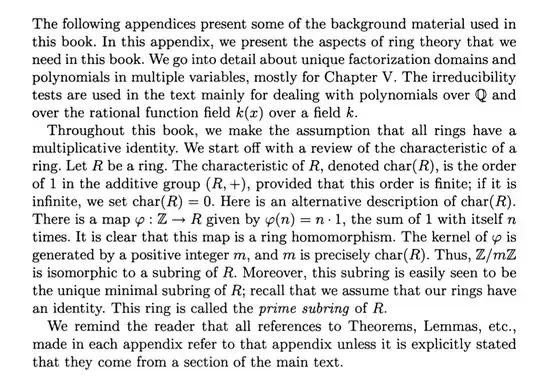I'm going to answer your questions in the reverse order.
(2) Not everyone assumes that rings have a multiplicative identity, so there is no consensus on the way to define a ring. On the other hand, I do think there is a consensus on the way to define a subring. Mathematicians define a subring $S$ of a ring $R$ to be a subset of $R$, such that when you restrict the operations of $R$ to $S$, $S$ becomes a ring. For mathematicians who do not assume that rings have a multiplicative identity, this just means that $S$ contains $0$, $S$ contains additive inverses, and $S$ is closed under addition and multiplication. For mathematicians who do assume that rings have a multiplicative identity, this means that $S$ contains $0$, $S$ contains additive inverses, $S$ is closed under addition and multiplication, and that $S$ contains the multiplicative identity of $R$ (i.e. $1_R\in S$).
Since your book is assuming that rings have multiplicative identities, your book is also assuming that if $S$ is a subring of $R$ then $S$ contains the multiplicative identity of $R$ (i.e. $1_R\in S$).
Also, please note that subrings and ideals are slightly different. Let $S\subseteq R$. Then $S$ is an ideal of $R$ iff the following hold:
$$0\in S.$$
$$\forall x,y\in S,\;x+y\in S.$$
$$\forall r\in R,\;\forall x\in S,\;r\cdot x\in S\text{ and }x\cdot r\in S.$$
And as we discussed a moment ago, $S$ is a subring of $R$ iff the following hold:
$$0\in S.$$
$$\forall x\in S,\;-x\in S.$$
$$\forall x,y\in S,\;x+y\in S.$$
$$\forall x,y\in S,\;x\cdot y\in S.$$
$$1_R\in S.$$
Notice that these definitions are slightly different. One consequence of this difference is the following: every subring of $R$ contains $1_R$, but the only ideal of $R$ that contains $1_R$ is $R$ itself.
(1) Let $P$ be the prime subring of $R$. The prime subring of $R$ is the unique minimal subring of $R$. What this means is (A) that $P$ is a subring of $R$, (B) that $P\subseteq S$ for every subring $S$ of $R$, and (C) that $P$ is the only subring of $R$ that satisfies properties (A) and (B). To prove these, use the fact that $P=\phi(\Bbb{Z})$ where the $\phi:\Bbb{Z}\to R$ is the ring homomorphism which sends $n\mapsto n\cdot1_R$ for all $n\in\Bbb{Z}$.
(A) In general, if $\psi:R_1\to R_2$ is a ring homomorphism, then $\psi(R_1)$ is a subring of $R_2$. Since $P$ is defined to be $\phi(\Bbb{Z})$, where $\phi:\Bbb{Z}\to R$ is the ring homomorphism which sends $n\mapsto n\cdot1_R$ for all $n\in\Bbb{Z}$, it follows that $P$ is a subring of $R$.
(B) Let $S$ be a subring of $R$. Then $1_R\in S$. Since $S$ contains additive inverses, we also have that $(-1)\cdot1_R=-1_R\in S$. Also, since $S$ is closed under addition, it can be shown that $n\cdot1_R\in S$ for all $n\in\Bbb{Z}$. Hence $P=\phi(\Bbb{Z})\subseteq S$.
(C) Suppose $P_1$, $P_2$ are subrings of $R$ such that $P_1\subseteq S$ for every subring $S$ of $R$ and $P_2\subseteq S$ for every subring $S$ of $R$. It follows that $P_1\subseteq P_2$ and $P_2\subseteq P_1$. Hence $P_1=P_2$.
